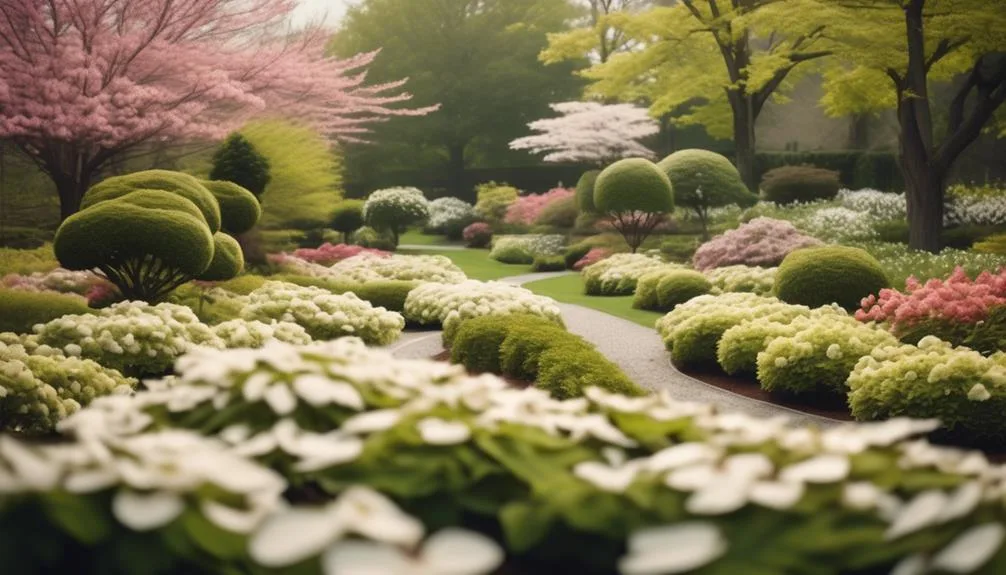Dogwood trees are a beautiful addition to any landscape, bringing timeless elegance and vibrant color. With the right placement and thoughtful companions, these trees can transform your outdoor space.
Whether you prefer a classic, understated look or a burst of springtime charm, dogwoods offer versatile possibilities. In this article, we'll explore how to incorporate the graceful allure of dogwood trees into your landscape design, creating a breathtaking haven for all to enjoy.
Dogwood Tree Varieties for Landscaping
When selecting dogwood tree varieties for your landscaping, consider factors such as size, bloom color, and adaptability to your specific climate and soil conditions.
Tree placement is crucial for the overall aesthetic and health of your landscape. Choose a spot with well-drained soil and partial shade to ensure the tree thrives. Additionally, consider the mature size of the tree to avoid future crowding or obstruction.
As for tree maintenance, dogwood trees generally require minimal care once established. However, regular watering, especially during dry periods, is essential for young trees. Pruning should be done during the dormant season to maintain the tree's shape and remove dead or damaged branches.
Ideal Planting Locations for Dogwood Trees
Selecting the ideal planting locations for your dogwood trees is crucial for ensuring their aesthetic appeal and overall health in your landscape design. When choosing spots for your dogwood trees, consider the following:
- Tree Spacing: Ensure that you plant your dogwood trees at a distance of 15-20 feet from other trees to allow for ample sunlight and airflow, which is essential for their growth and health.
- Soil Conditions: Dogwood trees thrive in well-draining, acidic soil with a pH level of 5.5 to 6.5. Make sure the soil is rich in organic matter and avoid heavy clay soils.
Properly chosen planting locations will contribute to the overall beauty and health of your dogwood trees, providing you with stunning seasonal color and the opportunity to implement effective pruning techniques.
Companion Plants for Dogwood Trees
Enhance the beauty and diversity of your landscape by carefully selecting companion plants that complement the stunning presence of your dogwood trees.
Consider tree underplanting with low-growing perennials such as hostas, ferns, or coral bells. These choices not only provide a beautiful ground cover but also thrive in the dappled shade provided by the dogwood's canopy.
For seasonal interest, pair your dogwood trees with plants that offer color contrast throughout the year. For example, consider planting spring bulbs like daffodils or tulips around the base of your dogwood for a burst of color in early spring.
In summer, companions like daylilies or astilbe can add vibrant pops of color.
Thoughtful perennial pairings will ensure that your dogwood trees remain the focal point of your landscape throughout the year.
Design Tips for Incorporating Dogwood Trees
Consider incorporating dogwood trees into your landscape design to add a touch of elegance and natural beauty.
When designing with dogwood trees, keep in mind the following tips to make the most of their stunning features:
- Pruning Techniques
- Prune dogwood trees during late fall or winter to enhance their shape and structure.
- Remove dead or diseased branches to promote healthy growth and maintain an attractive appearance.
- Seasonal Blooms
- Take advantage of the vibrant spring blooms of dogwood trees by planting them in locations that allow for maximum visibility.
- Pair them with evergreen shrubs or perennials to create a beautiful contrast during the winter months.
Maintenance and Care for Dogwood Trees
Keeping dogwood trees healthy and vibrant requires regular maintenance and care throughout the year. Proper pruning techniques and ensuring soil fertility are key aspects of dogwood tree care. When it comes to pruning, it's essential to remove dead or diseased branches to promote healthy growth and maintain an attractive shape. Additionally, pruning should be done during the dormant season to minimize stress on the tree. As for soil fertility, it's important to conduct soil tests to determine if any amendments are needed. Dogwood trees thrive in well-draining, acidic soils, so adding organic matter or using fertilizers specifically formulated for acid-loving plants can help maintain soil fertility. Regular watering, mulching, and monitoring for pests and diseases are also crucial for the overall health and longevity of dogwood trees.
| Pruning Techniques | Soil Fertility |
|---|---|
| Remove dead or diseased branches | Conduct soil tests |
| Prune during dormant season | Use organic matter or specific fertilizers |
| Promote healthy growth and shape | Ensure well-draining, acidic soil |
Conclusion
Incorporating dogwood trees into your landscape design brings beauty, color, and harmony to your outdoor space. Choose the right variety and companions, and with proper care, your garden will thrive for years to come.
Happy gardening!

My interest in trees started when I first saw the giant sequoias in Yosemite.
I was a teenager then, and I remember thinking, “I need to learn more about this.”
That moment stuck with me.
A few years later, I went on to study forestry at Michigan Tech.
Since graduating, I’ve worked in a mix of hands-on tree care and community education.
I’ve spent over ten years helping people understand how to plant, maintain, and protect the trees in their neighborhoods.
I don’t see trees as just part of the landscape.
They are living things that make a real difference in our daily lives.
